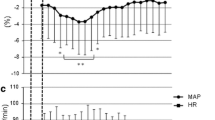Abstract
It has been suggested that cerebral oximetry can detect acute and chronic changes in cerebral oxygen saturation due to pregnancy related complications. Furthermore, regional cerebral oxygenation saturation (rcSO2) decreases were obtained during spinal anesthesia for cesarean section. The aim of this prospective observational study is to compare the effects of spinal anesthesia on rcSO2 in preeclamptic and normotensive pregnant women. Preeclamptic (Group P, n = 24) and normotensive (Group N, n = 25) women with gestational week 32 and above, and scheduled for cesarean section under spinal anesthesia were included in this study. In addition to routine monitoring, rcSO2 values obtained with right and left frontal cerebral sensors (rcSO2right and rcSO2left) were recorded before (baseline) spinal injection and during the surgery. The baseline rcSO2 values were similar in both groups. In Group P, rcSO2left values were higher than Group N only 3 and 5 min after spinal injection. In Group N, rcSO2 values decreased from baseline 1, 3, 5, and 10 min after spinal injection. In Group P, rcSO2 values decreased from baseline 1, 3, 5, 10, 30 and 35 min after spinal injection and at the end of the operation. There was no difference between the number of declines and the patients with rScO2 below the cerebral hypoxic threshold. There was a positive correlation between rcSO2 and blood pressure only 5 min after spinal injection, but no correlation with peripheral oxygen saturation was detected during the operation. There is decrease in rcSO2 values after spinal anesthesia correlating with hypotension in preeclamptic women. However, the decrease is less than that of normotensive pregnant women, especially the first 5 min after spinal injection when the blood pressure is lowest. The clinical impact of these results and the relationship between cerebral desaturation and neurological complications remain to be determined.





Similar content being viewed by others
References
Yamazaki K, Suzuki K, Itoh H, Muramatsu K, Nagahashi K, Tamura N, Uchida T, Sugihara K, Maeda H, Kanayama N. Cerebral oxygen saturation evaluated by near-infrared time-resolved spectroscopy (TRS) in pregnant women during caesarean section—a promising new method of maternal monitoring. Clin Physiol Funct Imaging. 2013;33(2):109–16.
Fassoulaki A, Paraskeva A, Tsaroucha A. Cesarean delivery under spinal anesthesia is associated with decreases in cerebral oxygen saturation as assessed by NIRS: an observational study. Curr Med Res Opin. 2014;30(3):331–7.
Jarraya A, Mohamed S, Sofiene L, Kolsi K. Near-infrared spectrometry in pregnancy: progress and perspectives, a review of literature. Pan Afr Med J. 2016;23:39.
Belfort MA, Clark SL, Sibai B. Cerebral hemodynamics in preeclampsia: cerebral perfusion and the rationale for an alternative to magnesium sulfate. Obstet Gynecol Surv. 2006;61(10):655–65.
Berlac PA, Rasmussen YH. Per-operative cerebral near-infrared spectroscopy (NIRS) predicts maternal hypotension during elective caesarean delivery in spinal anaesthesia. Int J Obstet Anesth. 2005;14(1):26–31.
Hirose N, Kondo Y, Maeda T, Suzuki T, Yoshino A. Relationship between regional cerebral blood volume and oxygenation and blood pressure during spinal anesthesia in women undergoing cesarean section. J Anesth. 2016;30(4):603–9.
Guerci P, Vial F, Feugeas J, Pop M, Baka NE, Bouaziz H, Losser MR. Cerebral oximetry assessed by near-infrared spectrometry during preeclampsia: an observational study: impact of magnesium sulfate administration. Crit Care Med. 2014;42(11):2379–86.
Report of the American. College of obstetricians and gynecologists’ task force on hypertension in pregnancy: executive summary. Obstetr Gynecol. 2013;122(5):1122–31.
Riskin-Mashiah S, Belfort MA, Saade GR, Herd JA. Transcranial doppler measurement of cerebral velocity indices as a predictor of preeclampsia. Am J Obstet Gynecol. 2002;187(6):1667–72.
Belfort MA, Saade GR, Grunewald C, Dildy GA, Abedejos P, Herd JA, Nisell H. Association of cerebral perfusion pressure with headache in women with pre-eclampsia. Br J Obstet Gynaecol. 1999;106(8):814–21.
Williams K, Galerneau F. Maternal transcranial Doppler in pre-eclampsia and eclampsia. Ultrasound Obstet Gynecol. 2003;21(5):507–13.
Ankichetty SP, Chin KJ, Chan VW, Sahajanandan R, Tan H, Grewal A, Perlas A. Regional anesthesia in patients with pregnancy induced hypertension. J Anaesthesiol Clin Pharmacol. 2013;29(4):435–44.
Henke VG, Bateman BT, Leffert LR. Focused review: spinal anesthesia in severe preeclampsia. Anesth Analg. 2013;117(3):686–93.
Rokamp KZ, Secher NH, Eiberg J, Lønn L, Nielsen HB. O2 supplementation to secure the near- infrared spectroscopy determined brain and muscle oxygenation in vascular surgical patients: a presentation of 100 cases. Front Physiol. 2014;5:66.
Foss VT, Christensen R, Rokamp KZ, Nissen P, Secher NH, Nielsen HB. Effect of phenylephrine vs. ephedrine on frontal lobe oxygenation during caesarean section with spinal anesthesia: an open label randomized controlled trial. Front Physiol. 2014;5:81.
Author information
Authors and Affiliations
Corresponding author
Ethics declarations
Conflict of interest
The authors have no conflicts of interest.
Rights and permissions
About this article
Cite this article
Karademir, A., Erdogan Kayhan, G. Cerebral oxygen saturation monitoring in preeclamptic pregnant women undergoing cesarean section with spinal anesthesia: a prospective, observational study. J Clin Monit Comput 33, 833–841 (2019). https://doi.org/10.1007/s10877-018-00237-0
Received:
Accepted:
Published:
Issue Date:
DOI: https://doi.org/10.1007/s10877-018-00237-0




